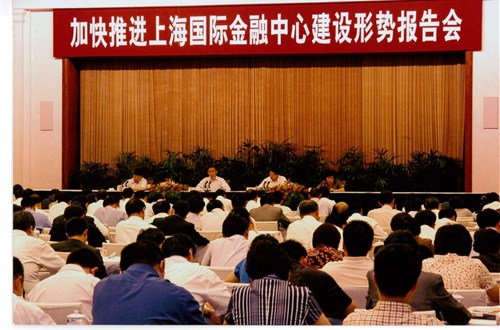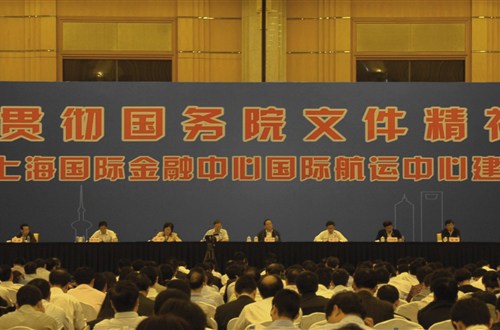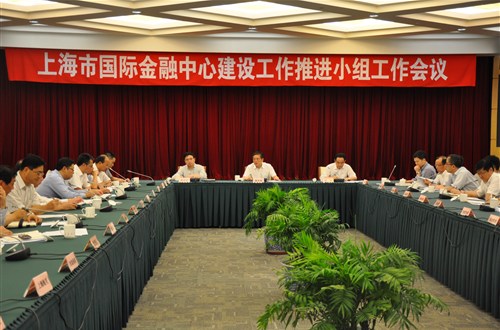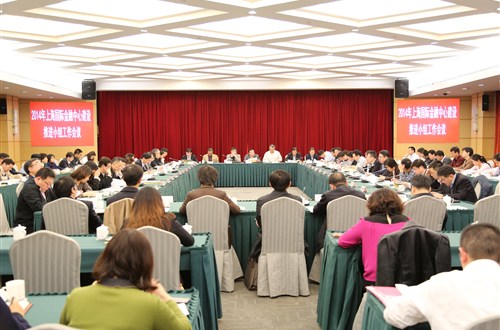Overview of Shanghai International Financial Center Construction

A meeting was held in 2005 to hear a report on efforts to accelerate the development of Shanghai International Financial Center.

The May 11, 2009 meeting reviewed the progress of construction of the Shanghai International Financial Center.

The group in charge of coordination work for the construction of Shanghai International Financial Center had a meeting on August 23, 2012.

A conference to promote the Shanghai International Financial Center was held on April 3, 2014.
Shanghai is an important port city by the western Pacific Ocean Coast. Its birthplace as the center of modern China finance combines an illustrious history and deep cultural heritage.
Since the opening of the city’s commercial port in the 1840s, Shanghai has thrived as a center for rapid industrial and commercial development, attracting investment and professionals from around the world.
By the 1930s, Shanghai was the undisputed financial center of the Far East with vibrant financial activities. Trading volumes of stocks and bonds here were second to none in Asia and trading volume of gold second was to London and New York.
A large number of banks, including the then Central Bank and the Bank of China, had their headquarters in Shanghai, making the city a national hub of currency issuance and foreign exchange. Shanghai’s financial industry was increasingly influential.
The status of Shanghai as an international financial center declined markedly by the late 1940s due to the impact of war and other political and economic factors.
After the founding of the People’s Republic of China in 1949, the central government implemented centralized management of the financial industry and relocated head offices of major financial institutions from Shanghai to Beijing. That began to reverse when China launched economic reforms and its policy of opening up to the world, beginning in the late 1970s. A new era was heralded by the decision to develop the Pudong New Area as a financial hub.
In January 1991, Deng Xiaoping said on a tour of the city that Shanghai would regain its former glory as a financial centre and a place for free exchange of currencies.
“Finance plays a crucial role in the modern economy,” Deng said. “A well-operating finance system is the key to everything. China will depend on Shanghai to build its international presence in finance.”
In October 1992, the 14th National Congress of the Communist Party of China passed a resolution “furthering the opening up of the cities along the Yangtze River, in tandem with the development and opening up of Shanghai’s Pudong area, and accelerating the construction of Shanghai as an international center of the economy, finance and trade.”
Thus was the path of construction of Shanghai as an international financial center solidly laid. Ensuing years have seen an acceleration in that process.
In 2009, the State Council promulgated “Opinions on Promoting the Development of Shanghai’s Modern Services Industry and Advanced Manufacturing Industry, and Promoting the Construction of the Shanghai International Financial Centre and International Shipping Center.”
In December 2011, the National Development and Reform Commission issued the “Guidelines for the Construction of the Shanghai International Financial Center in the 12th Five-Year Plan,” upon the approval of the State Council. The guidelines outlined a magnificent blueprint for Shanghai as an international financial center.
In recent years, Shanghai has focused on the development of a financial market system, on financial reform innovation, and on creating an optimal environment for finance. Several key factors merit attention.
• First, the financial market system is increasingly being optimized and market scale is expanding.
Shanghai has established a relatively complete national financial market system comprising stocks, bonds, currency, foreign exchange, commodity futures, financial futures, over-the-counter derivatives and gold.
Thanks to such a system, Shanghai’s stature as a center for the RMB exchange rate and interest rates has been consolidated. Shanghai’s financial markets have been enriched, with new products being added all the time. They include stock-index futures, treasury bond futures, gold futures, silver futures, zinc futures, lead futures, medium-term notes, short-term financing bonds, private placement notes, and credit risk mitigation warrants.
Shanghai’s financial markets have also witnessed a rapid growth in scale. Transaction volume of Shanghai’s financial markets amounted to 639 trillion yuan in 2013, a fourfold increase from 007.
In 2013, the stock transaction volume in Shanghai ranked No. 5 globally. The market value of its stocks ranked seventh, and the volume of exchange-traded spot transactions in the gold market ranked first. Volume of transaction in other futures, including copper, aluminum and natural rubber, also enjoyed top global rankings.
• Secondly, the financial institution system is maturing, and financial institutions are growing with striking vitality.
Commercial banks, security companies, insurance firms, fund management companies, and futures companies are gathering pace rapidly. New financial institutions are emerging, such as micro-credit lenders, financing guarantee companies and equity investment companies.
By the end of 2013, there were 1,317 financial institutions in Shanghai, compared with 500 at the end of 2007.
Along with the growth of financial institutions, innovations in financial operations have also been promoted. Pilot programs have been initiated for cross-border RMB trade settlement, foreign exchange management in the international trade settlement center, centralized operation and management of foreign exchange funds by multinational headquarters, and bonded delivery of futures.
• Thirdly, the opening-up of the financial industry has achieved major progress with stable improvements in the levels of internationalization.
In 2013, foreign banks with headquarters in Shanghai accounted for more than a half of all foreign lenders in Shanghai, and their collective assets accounted for more than 80 percent of all foreign banks in China’s mainland.
Joint-venture securities companies, joint-venture fund management companies and foreign property insurance companies in Shanghai accounted for nearly a half of all those in China’s mainland.
The scope of financial services open to foreign participation has been expanded, and the number and investment quota of Qualified Foreign Institutional Investors (QFII) have been further increased. Shanghai was the first city in China to launch cross-border trade settlement in RMB. Foreign institutions have been approved to use the RMB to directly invest in the interbank bond market. The Capital China Outbound RMB Fund and the cross-border ETF were successfully launched on a trial basis. Shanghai was the first city in China to launch the Qualified Foreign Limited Partner (QFLP) program.
• Fourthly, the environment for financial development has been enhanced in a sustainable manner, with obvious improvement in support services.
The legal framework for financial development has been upgraded constantly with the unveiling of “Rules on Promoting the Construction of International Financial Center in Shanghai,” as well as the establishment of the financial court, financial inspection department and financial arbitration court.
The development of the credit system and payment system has achieved major progress. The system of professional services has been steadily improved. The Xinhua 08 financial information and services platform was set up in Shanghai, while finance-related professional services including accounting, auditing, legal services, asset evaluation, credit ratings, investment consultancy, financial information and services outsourcing have similarly grown rapidly.
The planning and construction of a financial cluster have increased the capacity for more financial services in the Lujiazui Financial District and the Bund Financial Cluster.
The goals of building Shanghai into an international financial hub are:
• By 2015, the city should achieve the status of being a global center for innovation, trading, settlement and clearing of RMB-denominated products
• By 2020, Shanghai will be built into an international financial center that is compatible with China’s economic power and the global status of the RMB.
• In the 12th Five-Year Plan, the major tasks to build Shanghai into an international financial centers are expanding the breadth and depth of the financial markets and accelerating improvements in market systems; attracting and cultivating financial institutions with global competitiveness and industry-wide influence; building a cross-border RMB payment and settlement center and stepping up the development of modern financial infrastructure; increasing innovation and reform in financial markets so that financial services can serve economic and social development; building a cross-border RMB investment and financing center and improving the internationalization of the financial industry; and endeavoring to create a financial environment of global competitiveness.